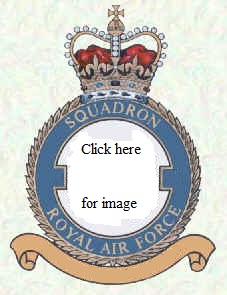Air of Authority - A History of RAF Organisation
No 271 - 275 Squadron Histories
Squadron Codes used: -
| ZJ | Allocated Apr - Sep 1939 |
| BJ | May 1940 -Jan 1944 |
| YS | Jan 1944 - Dec 1946 |
| L7 | Jan 1944 - Dec 1946 |
[Aircraft & Markings | Commanding Officers]
.
Squadron Codes used: -
| SM | Allocated Apr - Sep 1939 |
| XK | Nov 1940 - May 1941 |
| TJ | Possibly Allocated |
[Aircraft & Markings | Commanding Officers]
|
No Badge Authorised |
Formed at Burgh Castle on 30 July 1918 from No's 470, 485, 486 (Fighter) & 534 (Light Bomber) Flights, it was equipped with DH4, DH9, BE2c and Camels and conducted coastal reconnaissance sorties along the East Coast. The Camels provide fighter protection to the two-seater reconnaissance machines, which were supplemented by some DH9As in September. The squadron disbanded on 5 July 1919. The squadron reformed at China Bay, Ceylon on 1 August 1939, equipped with six Vickers Vildebeest torpedo bombers. It also operated four Fairey Seals belonging to the Station Flight, and with these two types it carried out coastal patrols, but the lack of enemy activity in the area led to it carrying out anti-aircraft co-operation duties. In March 1942, the squadron re-equipped with Fairey Fulmers, with half of the personnel also being naval. On 9 April a Japanese carrier force attacked Ceylon and the squadron lost one aircraft, after which the squadron began reconnaissance operations looking for further enemy vessels. When no further vessels were found the squadron resumed its defensive role, re-equipping with Hurricanes in August 1942 and Spitfire VIIIs in March 1944. The squadron eventually joined in the offensive against the Japanese in July 1944 when it moved to Burma and began ground attacks and escort duties in support of the 14th Army. With the end of hostilities it moved to Don Muang in Siam (Thailand) on 11 September 1945 and twelve days later moved to Tan Son Nhut in French Indo China (Vietnam), where it disbanded on 31 January 1946 |
Squadron Codes used: -
| HH | Aug 1939 - Sep 1939 |
| MS | Mar 1944 - Jan 1946 |
[Aircraft & Markings | Commanding Officers]
 Planned
as an anti-submarine squadron to be based at Seaton Carew from November 1918, it
never actually formed and the number was transferred to No 5 (Communications)
Squadron at Bircham Newton. The squadron was equipped with the Handley
Page V/1500 but following training, it was decided to concentrate on smaller
twin engined bombers and the unit was disbanded on 20 January 1920 with its personnel
forming the nucleus of No 207 Squadron.
Planned
as an anti-submarine squadron to be based at Seaton Carew from November 1918, it
never actually formed and the number was transferred to No 5 (Communications)
Squadron at Bircham Newton. The squadron was equipped with the Handley
Page V/1500 but following training, it was decided to concentrate on smaller
twin engined bombers and the unit was disbanded on 20 January 1920 with its personnel
forming the nucleus of No 207 Squadron.
Reformed at Amtiya in Egypt on 19 August 1940 it was equipped with both Hurricanes ('A' Flight) and Gladiators ('B' Flight). It also 6took over the Free French Flight previously attached to No 80 Squadron, however, this left in September and the following month 'B' Flight re-equipped with Hurricanes.
Between December 1940 and May 1942 the squadron was involved in fighter operations in the Western Desert interspersed with short periods of defensive duty back in Egypt. In May 1942 the squadron's aircraft were converted to the fighter-bomber role and it began ground attack operations in support of the 8th Army. When the squadron reached Tunisia the squadron reverted to the air defence role receiving some Spitfires in April 1943 which had left by August.
In September the squadron moved to Cyprus where it converted to Spitfires in October. These were taken to Italy in February 1944 and for the next two months it carried out offensive operations over the Balkans. However, on 10 April 1944 the squadron embarked for the UK and re-assembled on 24 April at Hornchurch. It was now part of 2nd Tactical Air Force and carried out the usual round of offensive operations in connection with the forthcoming invasion and provided cover to the invasion forces themselves.
August brought conversion to the Hawker Tempest V and these were put to immediate use in combating the V-1 flying bombs being unleashed against Britain at that time. With the V-1 threat abated the squadron moved to the Continent rejoining 2 TAF in September. Based in the Low Countries the squadron continued to support the Allied armies as they moved closer to Germany. In September 1945 the aircrews returned to Warmwell to take part in an armament practice camp and whilst there it was disbanded by being re-numbered No 174.
Squadron Codes used: -
| MU | Allocated Apr - Sep 1939 |
| YK | Aug 1940 - Sep 1940 |
| NH | xxx xxxx - Apr 1944 |
| JJ | Apr 1944 - Sep 1945 |
[Aircraft & Markings | Commanding Officers]
.
Squadron Codes used: -
| WS | Allocated Apr - Sep 1939 |
| PV | Oct 1941 - Feb 1945 |
[Aircraft & Markings | Commanding Officers]
Photos of 275 Sqn Personnel at RAF Andreas 1942
Squadron badge image on this page is courtesy of Steve Clements
© Crown Copyright is reproduced with the permission of the Directorate of Intellectual Property Rights
This page was last updated on 17/03/25©
![]() Organisational Index
Organisational Index ![]()